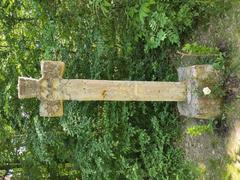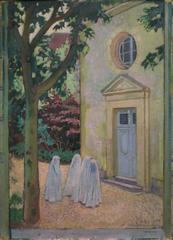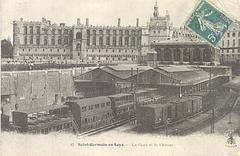Quartier De Gramont Visiting Guide: Saint-Germain-en-Laye, France
Date: 14/06/2025
Introduction
Nestled in the picturesque town of Saint-Germain-en-Laye, the Quartier de Gramont is a remarkable testament to France’s layered royal and military heritage. Established in the late 17th century as royal stables under King Louis XIV, the site was later transformed into elite cavalry barracks and played a significant role during the Napoleonic era and both World Wars. Today, while much of the complex remains residential and inaccessible to the public, its impressive architecture and historical resonance can be appreciated from the surrounding streets or during special heritage events. This guide offers detailed insights into the Quartier de Gramont, practical visiting information, and curated recommendations for exploring Saint-Germain-en-Laye’s wealth of historical and cultural attractions (POP: Quartier de Gramont; France-Voyage: Saint-Germain-en-Laye; Monumentum; Saint-Germain-en-Laye Official).
Contents
- Introduction
- Historical Overview of Quartier de Gramont
- Visiting Information
- Nearby Attractions
- Architectural Highlights
- Practical Visitor Tips
- Frequently Asked Questions (FAQ)
- Recommended Photographic Spots
- Conclusion & Visitor Recommendations
- Call to Action
- Sources and Further Reading
Historical Overview of Quartier de Gramont
Origins and Evolution
The Quartier de Gramont was originally constructed around 1670 as royal stables, known as the “écuries du manège,” under the directive of King Louis XIV. Its proximity to the Château de Saint-Germain-en-Laye placed it at the heart of royal life, supporting equestrian activities and ceremonies (POP: Quartier de Gramont). Over the centuries, the complex evolved to house elite cavalry units, including the Compagnie de Gramont and, later, the Imperial Guard’s cuirassiers during the Bourbon Restoration and Napoleonic periods (StGermainCommerce).
Twentieth-Century Significance
During World War II, the Quartier de Gramont was requisitioned by German forces and used as a command post, with bunkers constructed by Organisation Todt (Musée de la Résistance en Ligne). After the Liberation, the site became the headquarters for General Leclerc’s 2nd Armored Division until 1978. Today, the complex is protected as a Monument Historique, preserving its architectural and cultural significance (Monumentum).
Visiting Information
Access and Opening Hours
- General Access: The Quartier de Gramont is largely a private military residence and is not open to the general public. Its exterior can be admired year-round from surrounding streets.
- Special Events: Occasional guided tours or open days are organized during the Journées Européennes du Patrimoine (European Heritage Days) and other special heritage events. Details are published on the Saint-Germain-en-Laye official tourism website.
- No Admission Fee: As the site is not routinely open to visitors, there is no admission charge.
Getting There
- Public Transport: Take the RER A from Paris to Saint-Germain-en-Laye station (approx. 25–30 min). The Quartier is a 10-minute walk from the station.
- By Car: Limited parking is available; public transport is recommended, especially during peak times.
Accessibility
- While the interiors are not accessible, the surrounding streets are mostly flat and suitable for visitors with limited mobility. Some sidewalks may be uneven.
Nearby Attractions
Saint-Germain-en-Laye is home to several accessible and renowned landmarks, making it a rewarding day trip or extended visit.
- Château de Saint-Germain-en-Laye: A former royal residence housing the Musée d’Archéologie Nationale.
- Hours: Tuesday–Sunday, 10:00 AM–6:00 PM
- Tickets: €8; free for EU residents under 26
(Musée d’Archéologie Nationale Official Site)
- Grande Terrasse: A 2.4 km promenade designed by André Le Nôtre, offering panoramic views of the Seine Valley and Paris.
- Place du Marché: Lively markets on Wednesdays, Fridays, and Sundays.
- Maurice Denis Museum: Symbolist art collections and tranquil gardens.
(Musée Départemental Maurice Denis) - Forêt Domaniale de Saint-Germain: Expansive woodland for walking and cycling.
- Maison Natale Claude Debussy: Composer’s birthplace museum.
- Place Royale and Vieille Ville: Picturesque squares and historic streets.
Architectural Highlights
The Quartier de Gramont exemplifies robust 17th- and 19th-century military architecture, with limestone and brick façades, long-pitched tiled roofs, and notable sculptural details such as imperial eagles. The site’s monumental pediment (fronton) has been protected since 1929 (Monumentum).
Practical Visitor Tips
- Best Time to Visit: Spring and early autumn offer pleasant weather and vibrant gardens.
- Photography: The Rue de Paris façade and central courtyard (viewable from outside) are best captured in early morning or late afternoon light.
- Local Dining: Numerous cafés and bakeries in the old town and along Rue au Pain.
- Language: French is predominant, but basic English is understood in tourist areas.
- Respect Privacy: As the Quartier is residential, be mindful of noise and private property.
Frequently Asked Questions (FAQ)
Q: Can I visit inside the Quartier de Gramont?
A: No, the site is currently private and closed to the public except during rare heritage events.
Q: Are there guided tours?
A: Occasionally, during special events like European Heritage Days. Check the Saint-Germain-en-Laye tourism site for announcements.
Q: What are the best nearby sites to visit?
A: The Château de Saint-Germain-en-Laye, Maurice Denis Museum, Grande Terrasse, and local markets.
Q: Is the area accessible for people with mobility issues?
A: The streets around the Quartier are mostly flat, but some sidewalks can be uneven.
Q: How do I get there from Paris?
A: Take RER A to Saint-Germain-en-Laye; the Quartier is a short walk from the station.
Recommended Photographic Spots
- Quartier de Gramont Façade: Along Rue de Paris, especially the entrance with the imperial eagle.
- Grande Terrasse: For panoramic shots of the Seine Valley and Paris skyline.
- Château Courtyard: Especially atmospheric with historic architectural details.
- Local Markets: Capture lively scenes and regional produce at Place du Marché.
Conclusion & Visitor Recommendations
The Quartier de Gramont stands as a living monument to France’s royal and military legacy, even as it functions today as a private residence. Its architectural grandeur and historical context enrich the urban landscape of Saint-Germain-en-Laye, a town that offers much to discover—from royal châteaux and panoramic terraces to vibrant markets and museums. While interior access to the Quartier is limited, the surrounding area rewards visitors with art, history, and natural beauty. Use this guide to plan a seamless and enriching visit, and immerse yourself in the stories that continue to shape this remarkable region (Musée d’Archéologie Nationale Official Site; Visit Paris Region).
Call to Action
Enhance your visit to Saint-Germain-en-Laye with expert audio tours—download the Audiala app, follow us on social media for updates, and explore our in-depth articles on French heritage destinations.
Sources and Further Reading
- POP: Quartier de Gramont
- France-Voyage: Saint-Germain-en-Laye
- Saint-Germain-en-Laye Official Website
- Monumentum: Quartier de Gramont
- Musée d’Archéologie Nationale Official Site
- Visit Paris Region: Saint-Germain-en-Laye




